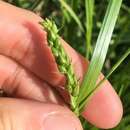Comments
provided by eFloras
Glabrous forms are sporadic in the western part of the range and were recognized as Carex davisii forma glabrescens by G. Kükenthal (1909) but do not warrant taxonomic recognition. A single collection of a putative sterile hybrid between C. davisii and C. hirsutella has been reported from Missouri (G. Yatskievych 1999+) but needs further study to confirm the parentage.
- license
- cc-by-nc-sa-3.0
- copyright
- Missouri Botanical Garden, 4344 Shaw Boulevard, St. Louis, MO, 63110 USA
Description
provided by eFloras
Plants densely cespitose. Culms dark maroon at base; flowering stems 30–100 cm, as long as leaves at maturity or a little shorter, 1.5–3 mm thick, glabrous or pubescent on angles. Leaves: basal sheaths maroon, bladeless, sheaths pubescent or rarely glabrous; others grading from maroon to green on back, light brown-hyaline on front, red dotted and usually pubescent distally, prolonged at apex; blades flat, 3–8 mm wide, usually pubescent on abaxial surface at least near sheath, minutely scabrous on margins. Inflorescences: peduncles of proximal spikes slender, 10–25 mm, pubescent; peduncle of terminal spike 10–30 mm, pubescent; proximal bracts equaling or often exceeding inflorescences; sheaths 15–45 mm; blades 2–6 mm wide. Lateral spikes 2–4, 1 per node, well separated or distal 2 usually overlapping terminal spike, mostly erect when young but at least proximal spikes nodding at maturity, pistillate with 10–40 perigynia attached 1 mm apart distally and to 4 mm apart proximally, cylindric, 10–50 × 3.5–6 mm. Terminal spike gynecandrous, sessile or pedunculate, 15–35 × 2–6 mm. Pistillate scales pale hyaline with broad green midrib, elliptic or ovate-lanceolate, body shorter than mature perigynia but extending into pubescent green awn 2.5–3 mm, often short-ciliate near apex. Perigynia green to olive-green, often red dotted, 2-ribbed with 9–12 almost equally prominent, evenly spaced veins extending from base to apex, slightly inflated around achene, ellipsoid-ovoid, 4.5–6 × 2–2.5 mm, membranous, base rounded, apex narrowing abruptly to minute beak, glabrous; beak bidentate, less than 0.5 mm. Achenes distinctly stipitate, 2.2–2.7 × 1–1.2 mm, stipe 1 mm.
- license
- cc-by-nc-sa-3.0
- copyright
- Missouri Botanical Garden, 4344 Shaw Boulevard, St. Louis, MO, 63110 USA
Habitat & Distribution
provided by eFloras
Fruiting late spring–mid summer. Floodplain forests; rich deciduous forests and forest margins, usually along streams or in ditches, wooded ravine slopes, meadows, fields and thickets; often associated with calcareous soils; Ont.; Ark., Conn., Del., Ill., Ind., Iowa, Kans., Ky., Md., Mass., Mich., Minn., Mo., Nebr., N.J., N.Y., Ohio, Okla., Pa., Tenn., Tex., Vt., W.Va., Wis.
- license
- cc-by-nc-sa-3.0
- copyright
- Missouri Botanical Garden, 4344 Shaw Boulevard, St. Louis, MO, 63110 USA
Comprehensive Description
provided by North American Flora
Carex davisii Schw. & Torr. Ann. Lye. N. Y. 1 : 326. 1825
Carex (anon.) no. 45, Muhl. Uescr. Gram. 254. 1817. (From "Cherokee.")
Carex aristata Dewey, Am. Jour. Sci. 7: 277. 1824. (Type from western Massachusetts.) Not
C. aristata Honck. 1792; nor C. aristata Clairv. 181 1 ; nor C. aristata R. Br. 1823. Carex Torreyana Dewey, Am. Jour. Sci. 10: 47. 1825. (Based on C. aristata Dewey.) Not C.
Torreyana Schw. 1824. Loxotrema Davisii Raf. Good Book 25. 1840. (Based on Carex Davisii Schw. & Torr.) Carex albirostris C. B. Clarke, Kew Bull. Add. Ser. 8: 78. 1908. (Type from Dallas, Texas.) Carex Davisii f. glabrescens Kukenth. in Engler, Pflanzenreich 4 20 : 588. 1909. (Type from Ohio.)
Cespitose, the rootstocks tough, dark-colored, the clumps medium sized, the culms 3-9 dm. high, slender, erect, from shorter to longer than the leaves, aphyllopodic, triangular, from noticeably pubescent to glabrous on the angles, strongly purple-tinged at base, the lower sheaths sometimes breaking and becoming filamentose; leaves 3-5 to a culm, evenly separated on the lower half, the blades ascending, flat, soft, deep-green, 1-3 dm. long, 3-8 mm. wide, long-attenuate, more or less soft-hairy (usually strongly so) especially on the under surface, the sheaths long, more or less hairy, yellowish-brown-tinged ventrally, concave at mouth, the ligule about as long as wide; terminal spike gynaecandrous, the lower two thirds staminate, and with few to several pistillate flowers above, peduncled, 1.5-3.5 cm. long, the staminate portion 1-2 mm. wide, the scales rather loose, lanceolate, awned, cuspidate, or acuminate, white-hyaline with green midrib; pistillate spikes 2 or 3, somewhat separate, erect or more or less drooping, on sparingly hairy peduncles usually shorter than the spikes, the spikes linearoblong or oblong-cylindric, 2-4 cm. long, 3-6 mm. wide, closely 1 0-40-flowered in few rows; bracts strongly sheathing, from shorter to longer than the culm, the lower leaf-like, the upper reduced; scales ovate-lanceolate, long-cuspidate, 3-ribbed, white-hyaline with green center, narrower and usually somewhat shorter than the perigynia; perigynia ascending, oblong-ovoid, 4-5 mm. long, 2-2.5 mm. wide, suborbicular or obscurely triangular in cross-section, inflated, green or in age yellowish-brown-tinged, glabrous, membranaceous, puncticulate, reddishbrown-dotted, rather strongly severalto many-nerved, round or round-tapering at base, and truncately very short-stipitate, rounded and very short-beaked at apex, the beak slender, white-tipped, bidentate or bidentulate; achenes oblong-obovoid, 2.5 mm. long, 1.75 mm. wide, triangular with concave sides and blunt angles, loosely enveloped in lower half of perigynia, yellowish, granular, slender, substipitate, slender-apiculate, jointed with the straight slender style; stigmas 3, slender, blackish, very short.
Type locality: "Hab. Williamstown, Massachusetts. Prof. Dewey."
Distribution: Alluvial woodlands, mostly in calcareous districts, Vermont and western Massachusetts to Minnesota, and southward to Maryland, Tennessee, and Texas. (Specimens examined from southwestern Quebec, Vermont, Massachusetts, Connecticut, New York, New Jersey, Pennsylvania, Delaware, Maryland, Ohio, Wisconsin, Indiana, Kentucky, Tennessee, Illinois, Minnesota, Iowa, Missouri, Kansas, Oklahoma, Texas.)
- bibliographic citation
- Kenneth Kent Mackenzie. 1935. (POALES); CYPERACEAE; CARICEAE. North American flora. vol 18(5). New York Botanical Garden, New York, NY

